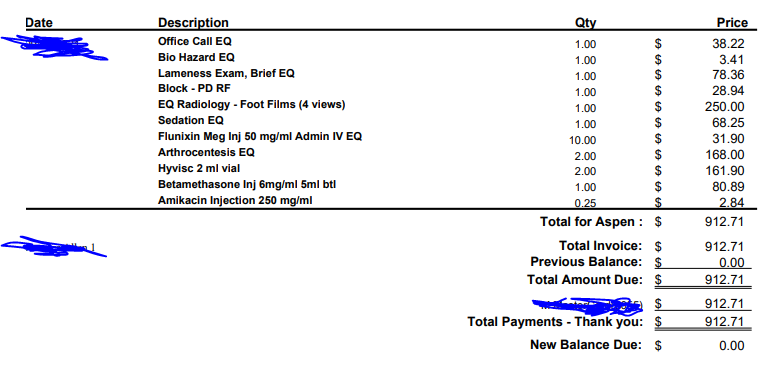My immediate reaction is that cost wise, this seems fairly reasonable. $250 for 4 hoof rads ($62.50 per view), $78.36 for a lameness eval… that’s all in line with what I’ve paid in a relatively low cost-of-living area.
It looks like they did a local anesthetic block of the RF hoof. Horse was sedated for some of the procedures and given Banamine (flunixin) intravenously for pain control. An arthrocentisis is the extraction of synovial fluid from the joint capsule - this can be for diagnostic or therapeutic purposes. The other 3 medications listed below that were likely part of the cocktail for the joint injection itself. Hyvisc is hyloronate sodium - it helps support the joint fluid. Betamethasone is a steroid to reduce inflammation. Amikacin is an antibiotic.
Office call - assuming you hauled in and no farm call. Overhead.
Biohazard - disposal of biohazardous waste (I.e. needles).
Exam and block and radiology and sedation - self-explanatory.
Flunixin = an NSAID (non-steroidal anti-inflammatory drug), anti-pyretic (fever reducer), analgesic (pain-reducing) med. Pharmacy cost.
Arthrocantesis - “a procedure that is performed to obtain synovial fluid from within a joint capsule, both for diagnostic and for therapeutic purposes”. Basically, removing fluid from a joint.
Other 3 are meds - pharmacy cost.
Assume everything has an up charge.
Well you have the office call, your horse got a Lameness exam, an xray or other imaging, sedation, and a nerve block before the injections or as part of the exam. She got Banamine /flunixin which is a muscle relaxant and pain killer. I’m assuming the last 4 items are part of the actual cocktail of the hock injections. Looks pretty standard to me.
Ah ok I conflated the arthrocantesis with the actual meds.
I’ve never done hock injections but my dental and vaxx bills itemize every unit of sedative and vaxx used.
Thank you all so much! I am a total newbie to reading vet stuff so this really helps!
Itemized vet bills are really useful because you get a permanent record of exactly what treatment the horse got. My vet even names the sedative and amount when he floats teeth. It’s useful when you want to repeat a treatment or try a new direction. Keep the bill on file!
And yes sticker shock always. Is horses.
Those are all standard meds and standard prices for coffin injections.
The farm call, biohazard, and rads should all be self explanatory. That’s a normal number of X-rays to take of a foot, for lameness purposes.
Flunixin is banamine. A lot of vets give an anti-inflammatory with joint injections, but not all.
The arthrocentesis is the actual joint injection and covers the cost of supplies like sterile gloves, syringes, scrubbing, etc.
Hyvisc is HA and standard for high motion joints, which coffin joints are.
Betamethasone is the steroid of choice for the joint injection.
Amikacin is an antibiotic that is usually given in the joint, with the other joint injection meds.
It’s all very standard and is a normal first approach for a horse that has no history lameness or has a diagnosed problem that needs occasional maintenance.
If you are concerned that it didn’t work, the first thing to keep in mind is that joint injections may take several days to a week to show a positive effect. Also, as I said, this is a standard approach for a horse with no history of lameness and is the most cost effective way to go about things. However, if your horse does not respond, she may need further diagnostics or therapy and you should definitely let your vet know if you don’t feel you got a good response from the injections.

